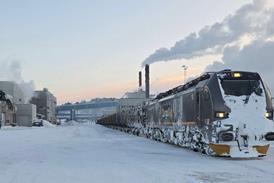OFFICIALLY unveiled at InnoTrans 2006, the Syntegra bogie from Siemens is the latest attempt to develop a gearless electric drive.
The concept brings together running gear, traction equipment and braking in 'a single mechatronic unit', with fewer mechanical parts than existing bogies. A pair of metro car bogies incorporating Syntegra three-phase drives has been tested at Wildenrath and will now spend a year running in revenue service under München U-Bahn car 7498 of Type B1.4.
The 150 kW synchronous motor uses the axle to carry a laminated rotor core surrounded by the neodymium-iron-boron permanent magnets (Fig 1). It is fully enclosed, and cooled by the natural airflow outside the cast-steel housing. Heat generated in the rotor and magnets is dissipated via the axle and wheels.
Fig 2 shows how the weight of the car bodies is transferred onto a central frame via air springs. Two low-level linkages and one at a higher level connect the axles to this central frame. Two longitudinal beams, which are balanced around their central fixing, transmit the weight to the primary springs, which are complemented by vertical shock absorbers. This assembly gives the effect of an articulated frame.
The bogie is linked to the car body via longitudinal linkages at two levels. Vertical shock absorbers dampen the movement of the air springs, and a horizontal damper limits transverse movement of the car body. Electro-dynamic brakes are used in normal operation to bring the train to a stand, and the block brakes acting on the 690/630 mm diameter wheels are only used for parking. Siemens proposes to use the inherent properties of the permanent magnet motor as a second electric brake. Connected to an external power circuit, the motors create a braking torque the heat will be dissipated via braking resistors. STS sees this as a truly independent second brake, which would also include wheelslip protection.
According to Siemens engineer Dr Lars Löwenstein, the reduction in mechanical components makes the Syntegra unit '2 tonnes lighter' than a conventional motor bogie. The weight of the prototype 1600 mm wheelbase bogies is 5·6 tonnes, but Siemens hopes to reduce this to 5 tonnes for a series build, giving a weight advantage of 'almost 30%'. Maximum axleload is 14 tonnes.
If the unsprung masses can be kept at comparable level with those of modern AC drives, and the short wheelbase bogie delivers good riding qualities at 80 km/h, Syntegra could prove to be a very interesting development. Doing away with gears would eliminate a source of noise and oil leakage, and the simplicity of the design with few wearing parts should lead to lower capital and maintenance costs.
While the first Syntegra drives are intended for metro trainsets running at up to 90 km/h, Siemens says little alteration to the design would be required for their use on 160 km/h main line vehicles.
Historical precedents
Interestingly, it is exactly 100 years since Asa Batchelder of General Electric pioneered the concept of gearless drives in the USA. Between 1906 and 1908 GE delivered 37 2 Do 2 locomotives rated at 1 250 kW to the New York Central, followed by 36 Bo-Bo-Bo-Bo locomotives of 1 830 kW in 1913-27 these weighed between 115 and 139 tonnes. The locos were used until the 1970s on the 100 km network of 660 V DC third-rail routes from Grand Central Terminal to White Plains and Croton-Harmon. Two-pole DC motors drove the axles directly to keep the unsprung mass within limits the axleload was restricted to 17 tonnes.
Perhaps the most spectacular gearless electric locomotives were the five 1BoDo+DoBo1 'Bipolar' locos for the 3 kV DC electrification on a 700 km section of the Milwaukee Railroad between Harlowton, Montana and Avery, Idaho. These 2 950 kW locos weighed no less than 236 tonnes.
A 2CoCo2 locomotive for 1·5 kV DC operation was delivered to the Paris - Orleans line in 1924, but was not a success. More recently ABB and later Adtranz delivered 78 Variotrams to four cities from 1993, powered by gearless wheel motors. Using a licence from Bombardier, Stadler has now received orders to supply a further 39 Variotram cars to three cities.n
- Fig 1. Cross section of the Syntegra gearless drive
- Fig 2. Two rocking beams transfer the car weight to the axles, and create the effect of an articulated bogie
- Photo: Two complete Syntegra bogies are to be tested under a München U-Bahn car

















